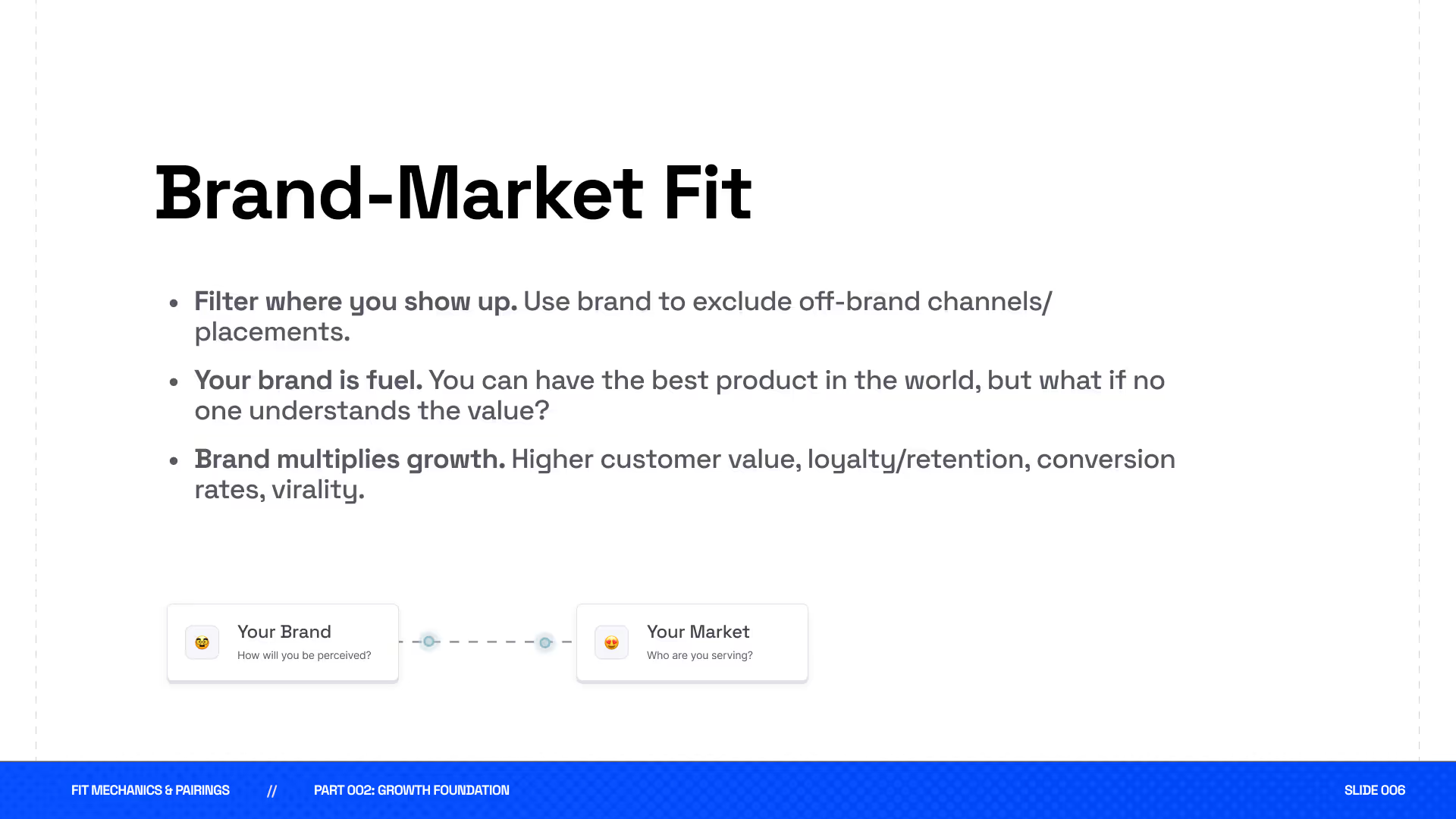
Conversation

🥳 Feedback Received!
Thanks for taking a moment to share your thoughts — it genuinely helps us make each chapter sharper.
What happens next:
- Your feedback goes straight to our product team.
- We’ll use it to refine lessons, clarify examples, and make the program even more useful.
Appreciate you helping make this program better for everyone.
Ready for your next challenge? 👇
Brand-market fit
Finally, let's talk about Brand-Market Fit. This is about ensuring your story and message resonate deeply with your target market.

1. The Great Multiplier
Brand is not just about logos and colors; it's about the story you tell.
When your brand—your story—resonates with your market, it acts as a powerful multiplier across your entire growth engine.
It increases customer loyalty, drives higher conversion rates, creates pricing power, and fuels word-of-mouth.
It also serves as a critical filter, telling you which channels and placements are "on-brand" and which you should avoid.
Brand can also function as a growth catalyst and viral acquisition driver in its own right.
When you have really strong Brand-Market Fit, people will talk about you just for your brand—not just your product, but what you stand for and how you show up in the world.
2. Assessing the Fit: How to Know You Have It
Since we define brand as story rather than just visual identity, assessing Brand-Market Fit involves monitoring both leading and lagging indicators across your marketing funnel and customer behavior.
Leading Indicators (Top-of-Funnel Signals): Brand-Market misalignment often shows up first in your marketing performance. If you're seeing subpar click-through rates across your top-of-funnel ad campaigns, this could signal that your story isn't resonating with your target market. Similarly, friction in your funnel—particularly low landing page conversion rates—can indicate misalignment. Since your story fuels your marketing messaging across channels and throughout the funnel, weak performance at these early touchpoints suggests your brand narrative isn't connecting with your market's motivations and values.
Lagging Indicators (Deeper Engagement Signals): You can have much more conviction about strong Brand-Market Fit when you see customers and users discussing not just your product, but your brand, your company, and what you stand for. This organic brand advocacy is one of the strongest signals of true alignment—when people talk about your worldview and how you show up in the world, not just what you do.
Brand-Driven Traffic: Steady increases in direct traffic are a supporting proxy for brand strength (capturing word-of-mouth and dark social). While direct traffic doesn't explicitly prove Brand-Market Fit (it could also come from product-driven word-of-mouth), it's certainly a positive signal. When you have really strong Brand-Market Fit, you should see that steady increase in people seeking you out directly.
Qualitative Feedback: Are customers using your brand's language in their reviews and testimonials? Are they talking about your product in a way that aligns with your intended positioning? This linguistic alignment shows that your story is not only being heard but internalized and repeated.
3. Important Considerations
Brand as Acquisition Driver: Unlike other fits that primarily optimize existing systems, strong Brand-Market Fit can actually become a standalone acquisition channel. When your story deeply resonates with your market, customers become brand evangelists who drive organic growth through their networks.
Story Evolution: Markets evolve, and so must your story. What resonates today may not resonate tomorrow as your market's values, challenges, and aspirations shift. Successful brands continuously refine their narrative while maintaining core authenticity.
Channel Amplification: Strong Brand-Market Fit doesn't just improve individual channel performance—it amplifies the effectiveness of all your other fits. When your story resonates, Product-Channel Fit becomes more effective, Model-Channel Fit economics improve, and even Product-Market Fit strengthens as brand affinity increases customer lifetime value.


